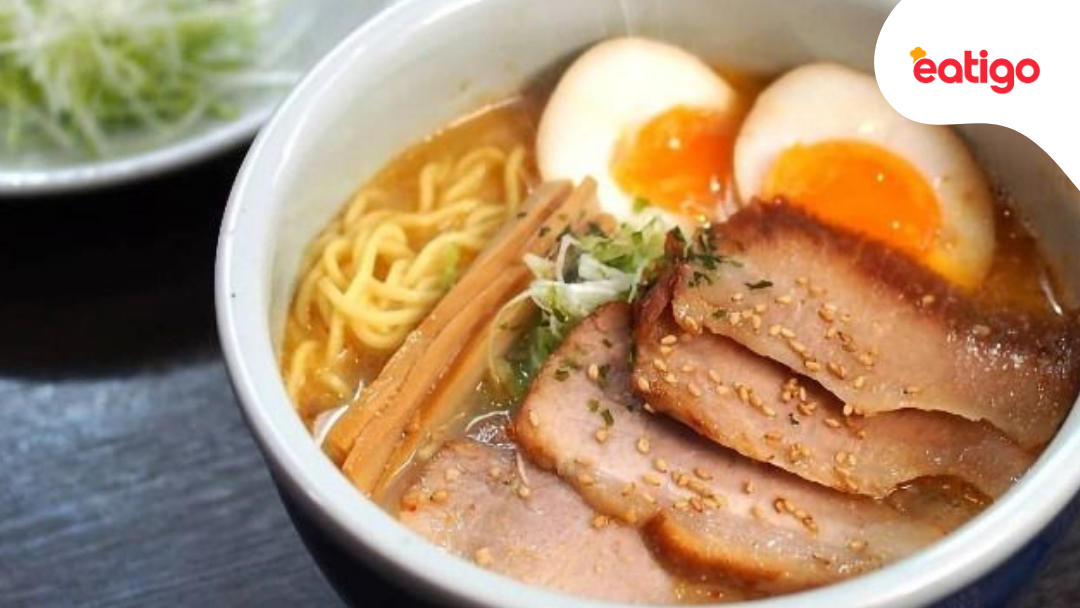Tsukemen vs Miso ramen – what’s the difference?

Shio vs shoyu ramen – what’s the difference?
October 3, 2024Kobe beef vs wagyu a5 – what’s the difference?
October 4, 2024Welcome to our blog, where we dive into the delicious world of Japanese food cuisine! Today, we’re exploring the intriguing rivalry between two beloved noodle dishes: Tsukemen and Miso Ramen. Both offer unique flavors and textures, but they each have their own distinct characteristics that set them apart. Whether you’re a ramen enthusiast or a newcomer curious about Japanese food, this post will break down the differences.
What’s the difference? Tsukemen vs Miso ramen
Tsukemen and Miso ramen are both Japanese noodle dishes, but they differ primarily in how they are served.
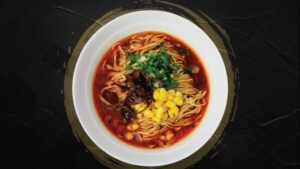
Tsukemen:
Tsukemen is a Japanese noodle dish that is a variation of ramen, characterized by its unique serving style. Here’s a detailed look at tsukemen:
- Noodles and Broth: Tsukemen noodles are typically thicker and chewier than regular ramen noodles. They are usually served cold or at room temperature. The broth for tsukemen is often more concentrated and flavorful than standard ramen broth. It can be made from various ingredients, including pork, chicken, seafood, or vegetables, and is usually seasoned with soy sauce or miso for added depth.
- Dipping Method: Diners dip the cold or room-temperature noodles into the hot, flavorful broth before eating, allowing for a unique texture and taste experience.
Miso Ramen:
Miso Ramen is a popular Japanese noodle dish characterized by its rich, flavorful broth made from miso paste. Here’s a detailed overview:
- Noodles and Broth: Ramen consists of noodles served in a hot broth, with all ingredients combined in a single bowl. The base of miso ramen is a combination of miso paste, water, and stock (typically made from pork, chicken, or vegetables). The result is a hearty and creamy broth that is both warming and satisfying. Miso ramen often uses medium to thick curly noodles that have a chewy texture, which helps them hold onto the rich broth.
- Serving Style: It’s typically eaten directly from the bowl, with toppings like chashu, green onions, and soft-boiled eggs mixed in.
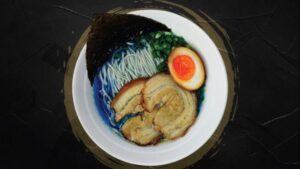
Regional Variations
- Hokkaido Style: Originating from the northern island of Hokkaido, this version often includes corn and butter as toppings, making it particularly rich and creamy.
- Tokyo Style: Typically features a lighter miso broth and a combination of toppings that may differ from the Hokkaido style.
Type of Ramen
There are several types of ramen, each distinguished by its broth, flavoring, and regional variations. Here are the most popular types:
1. Shoyu Ramen
Shoyu Ramen is a popular type of Japanese ramen characterized by its soy sauce-based broth. The word “shoyu” means soy sauce in Japanese, and this ramen variety is known for its light yet flavorful soup.
- Broth: Soy sauce-based
- Flavor: Savory, with a deep, slightly salty taste
- Appearance: Dark, clear broth
- Description: One of the most traditional forms of ramen, with a light but flavorful broth, often made from chicken or pork stock and flavored with soy sauce.
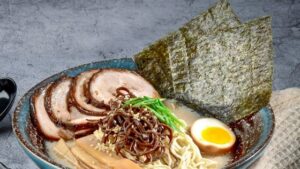
2. Shio Ramen
Shio Ramen is one of the four main types of Japanese ramen, distinguished by its light and delicate salt-based broth. “Shio” means salt in Japanese, and this variety is typically lighter and clearer compared to other ramen styles like shoyu or tonkotsu.
- Broth: Salt-based
- Flavor: Light, clear, and delicate
- Appearance: Pale or clear broth
- Description: The oldest form of ramen, known for its simple, clean flavor. The broth may be chicken, seafood, or vegetable-based, lightly seasoned with salt.
3. Miso Ramen
Miso Ramen is a flavorful and hearty type of ramen that originated in Hokkaido, Japan. This ramen is distinguished by its rich, savory broth made from miso paste, which gives it a slightly creamy texture and a deep umami flavor.
- Broth: Miso-based
- Flavor: Rich, hearty, and slightly sweet or tangy
- Appearance: Cloudy and thick due to miso paste
- Description: Originating from Hokkaido, miso ramen uses fermented soybean paste (miso) for a bold, umami-rich broth.
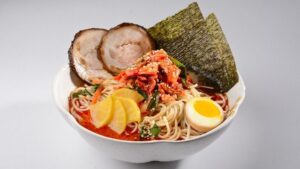
4. Tonkotsu Ramen
Tonkotsu Ramen is a rich and creamy type of ramen, famous for its broth made from pork bones that have been boiled for hours, often up to 12 hours or more. This process extracts the collagen and fat from the bones, creating a thick, milky-white broth that’s full of deep, savory flavors.
- Broth: Pork bone-based
- Flavor: Creamy, rich, and fatty
- Appearance: Milky white, thick broth
- Description: Made by simmering pork bones for hours to extract gelatin and collagen, resulting in a creamy, hearty broth that is one of the richest types of ramen.
5. Tsukemen
Tsukemen is a unique style of ramen where the noodles and broth are served separately. In this dish, you dip the noodles into a concentrated, flavorful dipping sauce (called tare) rather than having the noodles already immersed in the soup, as in traditional ramen.
- Broth: Dipping-style, concentrated broth
- Flavor: Bold and savory
- Appearance: Thick broth served separately from noodles
- Description: Noodles and broth are served separately, and diners dip the noodles into the broth. The broth is more concentrated than regular ramen soup.
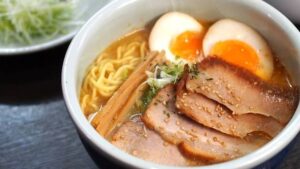
6. Hakata Ramen
Hakata Ramen is a type of tonkotsu (pork bone) ramen that originated in Fukuoka, specifically from the Hakata district, which is why it’s often referred to as Hakata-style ramen. It’s known for its rich, creamy pork bone broth and thin, firm noodles.
- Broth: Pork bone (tonkotsu) broth
- Flavor: Rich and creamy
- Appearance: Milky and thick, similar to tonkotsu ramen
- Description: Originating from the Hakata region, this ramen uses thin, straight noodles with a rich, creamy broth.
7. Kyushu Ramen
Kyushu Ramen refers to the style of ramen originating from Kyushu, the southernmost of Japan’s four main islands. It’s well-known for its rich and flavorful tonkotsu (pork bone) broth. Each region in Kyushu may have its own variation of ramen, but the most famous style is Hakata Ramen, which comes from Fukuoka, a major city on the island.
- Broth: Pork-based
- Flavor: Rich and savory
- Appearance: Creamy, similar to tonkotsu
- Description: From Kyushu, this ramen features a hearty pork bone broth and thinner noodles.
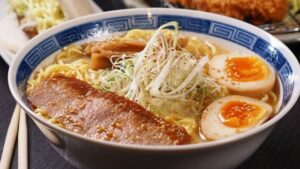
8. Tokyo Ramen
Tokyo Ramen is a style of ramen that originated in Tokyo, Japan’s bustling capital. It’s characterized by a light yet flavorful broth, which is typically soy-based (shoyu), making it different from the heavier tonkotsu broths of other regions like Kyushu. Tokyo ramen offers a balanced, comforting, and approachable flavor profile that reflects the city’s diverse food culture.
- Broth: Shoyu-based
- Flavor: Mild and savory
- Appearance: Clear, dark broth
- Description: A standard form of ramen from Tokyo, typically lighter than tonkotsu, and using soy sauce for seasoning.
9. Sapporo Ramen
Sapporo Ramen is a famous regional style of ramen from Sapporo, the capital of Hokkaido, Japan’s northernmost island. Known for its hearty, rich flavors, Sapporo ramen is particularly beloved for its miso-based broth and is designed to combat the region’s cold winters.
- Broth: Miso-based
- Flavor: Rich and savory
- Appearance: Cloudy broth, due to miso
- Description: Popular in Hokkaido, this ramen often includes butter and corn as toppings, and has a thicker broth.
10. Curry Ramen
Curry Ramen is a flavorful fusion dish that combines traditional Japanese ramen with the rich, aromatic taste of Japanese curry. It’s a relatively modern take on ramen that blends the comforting, hearty qualities of curry with the savory broth and noodles of ramen, resulting in a dish that’s both bold and warming.
- Broth: Curry-flavored
- Flavor: Spicy, rich, and aromatic
- Appearance: Dark, brownish broth
- Description: Incorporates Japanese curry powder into the broth, resulting in a hearty, aromatic ramen with a bit of spice.
Summary
Tsukemen and Miso Ramen both boast unique flavors and textures, yet each has its own specific traits that distinguish them. Whether you’re a ramen lover or new to Japanese cuisine, this post will clarify their differences, showcase the best ways to savor each dish, and assist you in choosing which one to sample next. Prepare for a tasty exploration that’s bound to make your mouth water!

